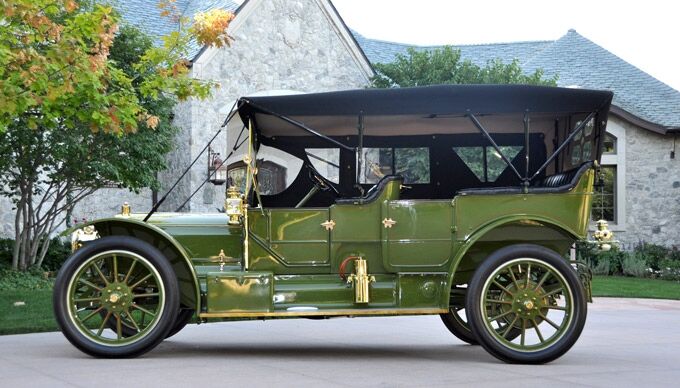In 1904, the Rambler Company relocated from Chicago to a factory in Kenosha, WI, where they pioneered assembly-line procedures and took their annual production to almost 4,000 units. By the turn of the next decade, with the last two-cylinder models phased out in favor of four-cylinder models, the Rambler became known as one of the most luxurious cars built in America. They were recognized by the slogan “The Comfort of the Parlor and the Speed of the Express Train.”
This outstanding Rambler Model 65 is widely believed to be the sole existing example of the model. Built on a 128-inch chassis, the longest offered, this gleaming Brass Era Seven-Passenger Touring Car is truly a sight to behold.
It is reported that the first owner of the Model 65 was an executive of the Coca-Cola Company in Laredo, TX. Built on the wide-track chassis — possibly the only Model 65 offered with that specification — the motorcar would have been well-suited to its owner, who most likely traveled the many unpaved roads of Texas that had been well-worn with the wide stance of horse-drawn wagons.
{auto}1601{/auto}
SCM Analysis
Detailing
| Vehicle: | 1911 Rambler Model 65 7-passenger touring |
| Years Produced: | 1902–13 |
| Number Produced: | Approximately 3,000 in 1911 |
| Original List Price: | $3,050 |
| SCM Valuation: | $200k–$300k |
| Tune Up Cost: | $750 |
| Distributor Caps: | N |
| Chassis Number Location: | N/A |
| Engine Number Location: | N/A |
| Club Info: | AACA 501 W Governor Road Hershey, PA |
| Website: | aaca.org |
| Alternatives: | 1914 Packard 4-48, 1913 Pierce-Arrow 48-8 |
| Investment Grade: | N |
This 1911 Rambler Model 65 Seven-Passenger Touring, Lot 67, sold for $275,000, including buyer’s premium, at Gooding & Company’s Amelia Island, FL, sale on March 9, 2012.
Cars like this Rambler are very hard to come by. Why? Because although this one is now 101 years old, it’s also still pretty original throughout. And it was fairly rare in its own time as well. It’s thought to possibly be the only wide-track Rambler Model 65 ever built.
Desired option or Achilles’ heel?
This striking Rambler was originally equipped with massive 40-inch-by-5-inch tires necessary for traveling the heavily rutted rural Texas roads of its day. In many cases, these were little more than trails beaten down by horse-drawn wagons, which happened to generally have wide tracks. So the large wheels and wide stance were perfect for the first buyer’s needs — these features kept the car from getting stuck, and it likely made things a little more comfortable than they might have been with smaller-diameter rims or more narrow axles.
But those wheels ultimately caused this Rambler to be parked relatively early in its life. The lack of availability of 40-inch replacement tires was a real problem — so much so that it necessitated the early retirement of the car. But in retrospect, that was a saving grace here, as when the car was uncovered many decades later, it was very complete, even retaining its original Laredo license plate.
Perfection in restoration
The restoration of the Rambler was complicated by the initial shop closing its doors. The subsequent restorer realized that the original (and quite rare) brass headlamps were missing. Fortunately, they were discovered in an unmarked box in the initial restorer’s now-closed facility. The Rambler was then restored to perfection, with every component disassembled and precisely restored. The acetylene headlamps and kerosene/electric running lights are in proper working order, and the original coil box was rebuilt in Europe.
The convertible top has never been lowered, which resulted in a deduction when the car was shown at the Pebble Beach Concours d’Elegance in 2008. The judges noted that the leather straps used for securing the lowered top did not have perforations for buckling the top, as the owner had never intended for it to be lowered. The Rambler did, however, go on to win a coveted class award.
Today, the Rambler Model 65 rides on smaller, more conventional wheels, although the original 40-inch wheels, which are marked “Coca-Cola,” were included with the sale.
Custom tires were sourced in Germany, and the wood wheels currently fitted have been restored. The radiator has also been slightly modified, and a 12-volt starter was installed.
A frequent auction flier
Since the Rambler was restored in 2008, it has been heavily marketed. It was frequently listed on eBay, with one seller looking for close to seven figures. It was reported as sold at Kruse International’s January 2009 Phoenix sale for $1,620,000. This was at the time, however, when the Kruse Auction empire was imploding, and few put much credence in their reports. In May of 2010, it was again offered by Worldwide Auctioneers at their Houston Classic sale, where it was a no-sale at $210,000. It was subsequently sold privately and was displayed at the LeMay Museum’s Club Auto in Denver.
Interest in higher-horsepower Brass Era cars continues unabated, as tours and other related activities fuel the market. A seven-figure price for this Rambler Model 65 is certainly not realistic in this market — that’s Duesenberg money — but the price realized at the Gooding and Company sale is. After all, it’s the only known example of a top-level early Rambler, it’s had a stunning restoration, and the Coca-Cola history makes the car a wonderful concours entrant. And at its core, it’s still a great touring car, just like it was back when it was new. At $275k, call it both well bought and sold
